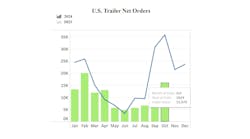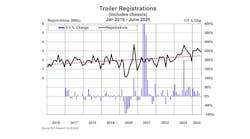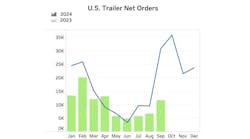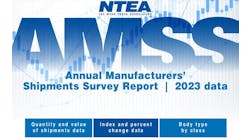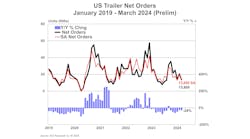Indianapolis. Rising freight rates should mean a couple of good years ahead for fleets and their equipment providers, according to forecasters here at the 2017 FTR Transportation Conference. But for 2020 and beyond, all bets are off as e-commerce, an increasingly automated supply chain, and the electrification of commercial vehicles will radically change the trucking business.
“Let me put this in as sharp a set of terms as I can think of,” said FTR Transportation Economist Noël Perry. “The changes we are looking at over the next 15 years are coming faster than anybody thinks. When the market changes, 90% of the incumbent customers, suppliers, carriers, brokers—and economists—will leave because we are not capable of dealing with that kind of change.”
And, he noted, his 15-year timeline might be conservative.
But for the near term, the outlook is good—very good, in fact.
North American Class 8 truck production will hit 300,000 units in 2018, a level seen only once in the past 10 years. Commercial vehicle trailer production will see a modest increase, paced by an improving flatbed market, while medium-duty truck production will mirror the U.S. economy, with slow but steady growth, according to the respective segment analyses that highlighted this year’s conference (and which are thoroughly detailed in the following pages).
In the freight market, spot trends indicate that more loads are being posted with fewer trucks competing for them, resulting in a 19% rate increase over last year, explained FTR Chairman and CEO Eric Starks.
“We are seeing noticeable rate pressure out there. We have not seen it moving into the contract rates, but I believe that we will see that very shortly,” Starks said—and that means carriers are in a better position to pay for things like drivers, and new equipment. “If you look at these numbers, we are not at levels we saw in 2014—but we are still at healthy, healthy levels going forward,” Starks said.
As for commercial trailer production, FTR CV equipment expert Don Ake noted that he had substantially underestimated the dry van market in the 2017 forecast, expecting production to be 150,000 units, but which he now estimates to be 177,000 units for 2017—an 18% difference, but virtually the same level as 2015 and 2016.
Ake projects dry van production again to remain flat, coming at 178,000 units in 2018. For refrigerated trailers, the mid-decade surge in demand will continue to taper off, down about 3% for 2018. Flatbed, in contrast, is making a “stronger and faster comeback” than expected, based economy-driven demand for the segment. Ake expects a 5% jump in 2018, to 23,200 flatbed units. He also anticipates “a decent recovery” in the dump trailer market (up 5%); while the liquid tank trailer forecast, based on improvement in the energy and chemical sectors, is “looking better, because they were so low,” resulting in 16% improvement.
FTR COO Jonathon Starks points to a small increase in demand driven by the economy and a “normalized” replacement cycle as the basis for FTR’s forecast of a 1.4% increase in medium-duty commercial vehicle production (212,300 units, up from 209,300)—but that’s a 7.3% improvement from 2016 (197,800).
“This isn’t significant growth, but it’s a very solid, stable, slow-growth environment,” Jonathon Starks said. “There’s some positive potential building for 2018, 2019, but it’s not transformational amounts; it’s incremental amounts.”
But those FTR numbers might be optimistic, or at least premature, counters Jeff Kauffman, managing director at Aegis Capital Corp. Invited to present an “alternative” equipment forecast, he contends that improving market conditions won’t provide truckers the margins they need to make capital investments until mid-2018, pushing sales into 2019.
“Most fleets have had the [equipment] numbers where they wanted them to be before this year, so there’s no catch-up on the heavy-duty side,” Kauffman said. “I just don’t see 300,000 next year—maybe in 2019, after carriers have had a year of P&L under their belt, a year to figure out ELDs, after a year with better margins to put new drivers in training schools. Then I can see that happening.”
As for Perry’s gloomy scenario, Steve Sashihara, CEO of Princeton Consultants, made a similar case. Indeed, his presentation included a refutation of the freight community’s reasoning for why the Uber model would not “disintermediate” the supply chain the same way it has the taxi business.
Simply, electric, autonomous vehicles—and the public’s growing level of comfort therefore demand on the passenger car side—will provide the impetus for the technology to disrupt trucking. Sashihara predicted that convoys of driverless vehicles—tractors stripped of driver comforts and conveniences—will travel overnight on interstates between freight hubs, and this will become the “new intermodal” model for long-haul trucking.
And, he continued, the idea that freight moves are too complex for an app simply won’t hold up—coming technologies will be that good, and all those load managers working the freight matching screens today will be gone.
Sashihara does offer a strategy for survival, however. For a small player, “pick a niche.” That is, specialize in a service that requires hands-on expertise. For a company that’s big today, it’s time to get with the program and automate “every aspect” of your core business. Businesses caught in the middle are going to have to scale up or scale down, but “don’t be the worst of both.”
The good news, for the survivors, is that when transportation services become “twice as fast for half the cost,” then people will find new ways to use it—the economic principle of “elasticity,” Perry concluded. And while the next couple of years “look pretty good” for transportation providers, the long-term environment is “full of profound risk—and profound opportunities.”
“We know from history that those of us who figure out how to take part, how to align ourselves with the people who see the answers, those of us who do that will become rich and famous,” he said.

